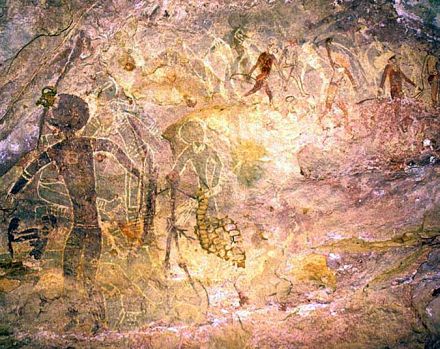io9 June 24 2013

The Sahara in central Africa is the largest hot desert on Earth, its blistering sands practically lifeless. But just a few thousand years ago, it was a home to early human civilizations.
Over the past decade, we’ve gotten a sharp picture of what happened to the people who lived in this lost landscape.
Roughly the size of the United States, the Sahara stretches across several African and Middle Eastern countries, including Egypt, Chad, Sudan, Libya, Algeria and more.
Today, the desert is vast and forbidding. But a few brave archaeologists who traveled deep into the western reaches of the area over the past hundred years have discovered something incredible. There are enormous murals of paleolithic rock art stretching back at least 10,000 years, depicting everything from animals to the clothing people wore during village ceremonies.
Often the people in these paintings are drawn with very round heads, a characteristic Saharan style. Paintings that share this style probably come from peoples with similar cultural origins. As the centuries passed, the paintings become more sophisticated and we see images that show bronze age tools, people riding horses, and using clay pots. The question is, what happened to these people? How did they live in such arid conditions? Where did they go?
Stefan Kröpelin is an archaeologist from Germany who wanted to find out. He and his team ventured out into the unexplored desert every year for decades, looking for clues. They tracked the locations of these cave paintings, and along the way they began to discover signs of what the Sahara had been like thousands of years ago. In massive, dry valleys they found shells and fish skeletons. They found remnants of trees and traces of pollen.
They realized that what they were witnessing was a history of climate change in the region. A once-fertile land of rains and lakes had dried up into a Martian landscape in just over 10,000 years. And as the rains moved, so too did the people.
In a 2006 paper, Kröpelin and his team explain this chart of human occupation (click to enlarge). Red dots are areas of long-term human habitation, and white dots show transient human occupation. What they suggest is that after a long arid period during the last ice age, the Sahara began to experience heavy monsoons starting about 8500 years BCE. The whole region became a grassy savannah, full of edible plants and animals, and people moved from the Nile valley deep into the eastern Sahara. As the monsoons grew milder, about 7000 BCE, people moved south too. But then, about 5300 BCE, the monsoons began to dry up. That’s when people began to cluster back around the Nile again.
